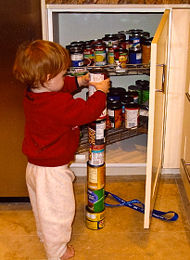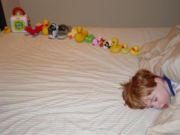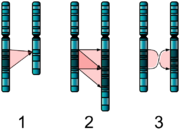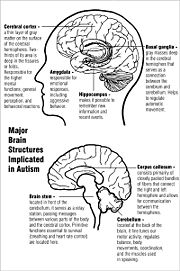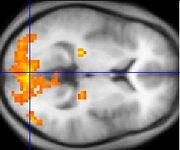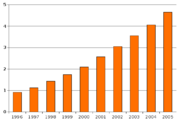Autism
2008/9 Schools Wikipedia Selection. Related subjects: Health and medicine
| Autism Classification and external resources |
|
| Repetitively stacking or lining up objects may indicate autism. | |
| ICD- 10 | F 84.0 |
| ICD- 9 | 299.0 |
| OMIM | 209850 |
| DiseasesDB | 1142 |
| MedlinePlus | 001526 |
| eMedicine | med/3202 ped/180 |
| MeSH | D001321 |
Autism is a brain development disorder that impairs social interaction and communication and causes restricted and repetitive behaviour, all starting before a child is three years old. This set of signs distinguishes autism from milder autism spectrum disorders (ASD) such as Asperger syndrome.
Autism has a strong genetic basis, although the genetics of autism are complex and it is unclear whether ASD is explained more by multigene interactions or by rare mutations. In rare cases, autism is strongly associated with agents that cause birth defects. Other proposed causes, such as childhood vaccines, are controversial; the vaccine hypotheses lack convincing scientific evidence. Most recent reviews estimate a prevalence of one to two cases per 1,000 people for autism, and about six per 1,000 for ASD, with ASD averaging a 4.3:1 male-to-female ratio. The number of people known to have autism has increased dramatically since the 1980s, at least partly due to changes in diagnostic practice; the question of whether actual prevalence has increased is unresolved.
Autism affects many parts of the brain; how this occurs is poorly understood. Parents usually notice signs in the first two years of their child's life. Early behavioural or cognitive intervention can help children gain self-care, social, and communication skills. There is no known cure. Few children with autism live independently after reaching adulthood, but some become successful, and an autistic culture has developed, with some seeking a cure and others believing that autism is a condition rather than a disorder.
Classification
Autism is a brain development disorder that first gives signs during infancy or childhood and generally follows a steady course without remission or relapse. Impairments result from maturation-related changes in various systems of the brain. Autism is one of the five pervasive developmental disorders (PDD), which are characterized by widespread abnormalities of social interactions and communication, and severely restricted interests and highly repetitive behaviour.
Of the other four PDD forms, Asperger syndrome is closest to autism in signs and likely causes; Rett syndrome and childhood disintegrative disorder share several signs with autism, but may have unrelated causes; PDD not otherwise specified (PDD-NOS) is diagnosed when the criteria are not met for a more specific disorder. Unlike autism, Asperger's has no substantial delay in language development. The terminology of autism can be bewildering, with autism, Asperger's and PDD-NOS often called the autism spectrum disorders (ASD) or sometimes the autistic disorders, whereas autism itself is often called autistic disorder, childhood autism, or infantile autism. In this article, autism refers to the classic autistic disorder, while other sources sometimes use autism or the autisms to refer to ASD, or equate ASD with PDD. ASD, in turn, is a subset of the broader autism phenotype (BAP), which describes individuals who may not have ASD but do have autistic-like traits, such as avoiding eye contact.
The manifestations of autism cover a wide spectrum, ranging from individuals with severe impairments—who may be silent, mentally disabled, and locked into hand flapping and rocking—to less impaired individuals who may have active but distinctly odd social approaches, narrowly focused interests, and verbose, pedantic communication. Sometimes the syndrome is divided into low-, medium- and high-functioning autism (LFA, MFA, and HFA), based on IQ thresholds, or on how much support the individual requires in daily life; these subdivisions are not standardized and are controversial. Autism can also be divided into syndromal and non-syndromal autism, where the former is associated with severe or profound mental retardation or a congenital syndrome with physical symptoms, such as tuberous sclerosis. Although individuals with Asperger's tend to perform better cognitively than those with autism, the extent of the overlap between Asperger's, HFA, and non-syndromal autism is unclear.
Some studies have reported diagnoses of autism in children due to a loss of language or social skills after 14 months of age, as opposed to a failure to make progress. Several terms are used for this phenomenon, including regressive autism, setback autism, and developmental stagnation. The validity of this distinction remains controversial; it is possible that regressive autism is a specific subtype.
The inability to identify biologically meaningful subpopulations has hampered research into causes. It has been proposed to classify autism using genetics as well as behaviour, with the name Type 1 autism denoting rare autism cases that test positive for a mutation in the gene contactin associated protein-like 2 (CNTNAP2).
Characteristics
Autism is distinguished by a pattern of symptoms rather than one single symptom. The main characteristics are impairments in social interaction, impairments in communication, restricted interests and repetitive behaviour. Other aspects, such as atypical eating, are also common but are not essential for diagnosis. Individual symptoms of autism occur in the general population and appear not to associate highly, without a sharp line separating pathological severity from common traits.
Social development
People with autism have social impairments and often lack the intuition about others that many people take for granted. Noted autistic Temple Grandin described her inability to understand the social communication of neurotypicals as leaving her feeling "like an anthropologist on Mars".
Social impairments become apparent early in childhood and continue through adulthood. Autistic infants show less attention to social stimuli, smile and look at others less often, and respond less to their own name. Autistic toddlers have more striking social deviance; for example, they have less eye contact and anticipatory postures and are more likely to communicate by manipulating another person's hand. Three- to five-year-old autistic children are less likely to exhibit social understanding, approach others spontaneously, imitate and respond to emotions, communicate nonverbally, and take turns with others. However, they do form attachments to their primary caregivers. They display moderately less attachment security than usual, although this feature disappears in children with higher mental development or less severe ASD. Older children and adults with ASD perform worse on tests of face and emotion recognition.
Contrary to common belief, autistic children do not prefer to be alone. Making and maintaining friendships often proves to be difficult for those with autism. For them, the quality of friendships, not the number of friends, predicts how lonely they are.
There are many anecdotal reports, but few systematic studies, of aggression and violence in individuals with ASD. The limited data suggest that in children with mental retardation, autism is associated with aggression, destruction of property, and tantrums. Dominick et al. interviewed the parents of 67 children with ASD and reported that about two-thirds of the children had periods of severe tantrums and about one-third had a history of aggression, with tantrums significantly more common than in children with a history of language impairment.
Communication
About a third to a half of individuals with autism do not develop enough natural speech to meet their daily communication needs. Differences in communication may be present from the first year of life, and may include delayed onset of babbling, unusual gestures, diminished responsiveness, and the desynchronization of vocal patterns with the caregiver. In the second and third years, autistic children have less frequent and less diverse babbling, consonants, words, and word combinations; their gestures are less often integrated with words. Autistic children are less likely to make requests or share experiences, and are more likely to simply repeat others' words ( echolalia) or reverse pronouns. Joint attention seems to be necessary for functional speech, and deficits in joint attention seem to distinguish infants with ASD: for example, they may look at a pointing hand instead of the pointed-at object, and they consistently fail to point at objects in order to comment on or share an experience. Autistic children may have difficulty with imaginative play and with developing symbols into language.
In a pair of studies, high-functioning autistic children aged 8–15 performed equally well, and adults better than individually matched controls at basic language tasks involving vocabulary and spelling. Both autistic groups performed worse than controls at complex language tasks such as figurative language, comprehension and inference. As people are often sized up initially from their basic language skills, these studies suggest that people speaking to autistic individuals are more likely to overestimate what their audience comprehends.
Repetitive behaviour
Autistic individuals display many forms of repetitive or restricted behavior, which the Repetitive Behaviour Scale-Revised (RBS-R) categorizes as follows.
- Stereotypy is apparently purposeless movement, such as hand flapping, head rolling, or body rocking.
- Compulsive behaviour is intended and appears to follow rules, such as arranging objects in a certain way.
- Sameness is resistance to change; for example, insisting that the furniture not be moved or refusing to be interrupted.
- Ritualistic behaviour involves the performance of daily activities the same way each time, such as an unvarying menu or dressing ritual. This is closely associated with sameness and an independent validation has suggested combining the two factors.
- Restricted behaviour is limited in focus, interest, or activity, such as preoccupation with a single television program.
- Self-injury includes movements that injure or can injure the person, such as biting oneself. Dominick et al. reported that self-injury at some point affected about 30% of children with ASD.
No single repetitive behaviour seems to be specific to autism, but only autism appears to have an elevated pattern of occurrence and severity of these behaviors.
Other symptoms
Autistic individuals may have symptoms that are independent of the diagnosis, but that can affect the individual or the family. An estimated 0.5% to 10% of individuals with ASD show unusual abilities, ranging from splinter skills such as the memorization of trivia to the extraordinarily rare talents of prodigious autistic savants.
Unusual responses to sensory stimuli are more common and prominent in autistic children, although there is no good evidence that sensory symptoms differentiate autism from other developmental disorders. Differences are greater for under-responsivity (for example, walking into things) than for over-responsivity (for example, distress from loud noises) or for seeking (for example, rhythmic movements). Several studies have reported associated motor problems that include poor muscle tone, poor motor planning, and toe walking; ASD is not associated with severe motor disturbances.
Atypical eating behaviour occurs in about three-quarters of children with ASD, to the extent that it was formerly a diagnostic indicator. Selectivity is the most common problem, although eating rituals and food refusal also occur; this does not appear to result in malnutrition. Although some children with autism also have gastrointestinal (GI) symptoms, there is a lack of published rigorous data to support the theory that autistic children have more or different GI symptoms than usual; studies report conflicting results, and the relationship between GI problems and ASD is unclear.
Sleep problems are known to be more common in children with developmental disabilities, and there is some evidence that children with ASD are more likely to have even more sleep problems than those with other developmental disabilities; autistic children may experience problems including difficulty in falling asleep, frequent nocturnal awakenings, and early morning awakenings. Dominick et al. found that about two-thirds of children with ASD had a history of sleep problems.
Parents of children with ASD have higher levels of stress. Siblings of children with ASD report greater admiration of and less conflict with the affected sibling; siblings of individuals with ASD have greater risk of negative well-being and poorer sibling relationships as adults.
Causes
Autism has a strong genetic basis, although the genetics of autism are complex and it is unclear whether ASD is explained more by multigene interactions or by rare mutations with major effects. Early studies of twins estimated heritability explains more than 90% of the risk of autism, assuming a shared environment and no other genetic or medical syndromes. However, most of the mutations that increase autism risk have not been identified. Typically, autism cannot be traced to a Mendelian (single-gene) mutation or to single chromosome abnormalities such as Angelman syndrome or fragile X syndrome, and none of the genetic syndromes associated with ASDs has been shown to selectively cause ASD. There may be significant interactions among mutations in several genes, or between the environment and mutated genes. Numerous candidate genes have been located, with only small effects attributable to any particular gene. The large number of autistic individuals with unaffected family members may result from copy number variations (CNVs)—spontaneous deletions or duplications in genetic material during meiosis. Hence, a substantial fraction of autism may be highly heritable but not inherited: that is, the mutation that causes the autism is not present in the parental genome.
All known teratogens (agents that cause birth defects) related to the risk of autism appear to act during the first eight weeks from conception, and though this does not exclude the possibility that autism can be initiated or affected later, it is strong evidence that autism arises very early in development. Although evidence for other environmental causes is anecdotal and has not been confirmed by reliable studies, extensive searches are underway. Environmental factors that have been claimed to contribute to or exacerbate autism, or may be important in future research, include certain foods, infectious disease, heavy metals, solvents, diesel exhaust, PCBs, phthalates and phenols used in plastic products, pesticides, brominated flame retardants, alcohol, smoking, illicit drugs, vaccines, and prenatal stress. Although parents may first become aware of autistic symptoms in their child around the time of a routine vaccination, and parental concern about vaccines has led to a decreasing uptake of childhood immunizations and an increasing likelihood of measles outbreaks, there is overwhelming scientific evidence showing no causal association between the measles-mumps-rubella vaccine and autism, and there is no scientific evidence that the vaccine preservative thiomersal helps cause autism.
Mechanism
Despite extensive investigation, how autism occurs is not well understood. Its mechanism can be divided into two areas: the pathophysiology of brain structures and processes associated with autism, and the neuropsychological linkages between brain structures and behaviors. The behaviors appear to have multiple pathophysiologies.
Pathophysiology
Autism appears to result from developmental factors that affect many or all functional brain systems, and to disturb the course of brain development more than the final product. Neuroanatomical studies and the associations with teratogens strongly suggest that autism's mechanism includes alteration of brain development soon after conception. This localized anomaly appears to start a cascade of pathological events in the brain that are significantly influenced by environmental factors. Although many major structures of the human brain have been implicated, almost all postmortem studies have been of individuals who also had mental retardation, making it difficult to draw conclusions. Brain weight and volume and head circumference tend to be greater in autistic children. The cellular and molecular bases of pathological early overgrowth are not known, nor is it known whether the overgrown neural systems cause autism's characteristic signs. Current hypotheses include:
- An excess of neurons that causes local overconnectivity in key brain regions.
- Disturbed neuronal migration during early gestation.
- Unbalanced excitatory-inhibitory networks.
- Abnormal formation of synapses and dendritic spines.
Interactions between the immune system and the nervous system begin early during embryogenesis, and successful neurodevelopment depends on a balanced immune response. Several symptoms consistent with a poorly regulated immune response have been reported in autistic children. It is possible that aberrant immune activity during critical periods of neurodevelopment is part of the mechanism of some forms of ASD. As autoantibodies have not been associated with pathology, are found in diseases other than ASD, and are not always present in ASD, the relationship between immune disturbances and autism remains unclear and controversial.
Several neurotransmitter abnormalities have been detected in autism, notably increased blood levels of serotonin. Whether these lead to structural or behavioural abnormalities is unclear. Also, some inborn errors of metabolism are associated with autism but probably account for less than 5% of cases.
The mirror neuron system (MNS) theory of autism hypothesizes that distortion in the development of the MNS interferes with imitation and leads to autism's core features of social impairment and communication difficulties. The MNS operates when an animal performs an action or observes another animal of the same species perform the same action. The MNS may contribute to an individual's understanding of other people by enabling the modeling of their behaviour via embodied simulation of their actions, intentions, and emotions. Several studies have tested this hypothesis by demonstrating structural abnormalities in MNS regions of individuals with ASD, delay in the activation in the core circuit for imitation in individuals with Asperger's, and a correlation between reduced MNS activity and severity of the syndrome in children with ASD. However, individuals with autism also have abnormal brain activation in many circuits outside the MNS and the MNS theory does not explain the normal performance of autistic children on imitation tasks that involve a goal or object.
A 2008 study of autistic adults found evidence for altered functional organization of the task-negative network, a large-scale brain network involved in social and emotional processing, with intact organization of the task-positive network, used in sustained attention and goal-directed thinking. A 2008 brain-imaging study found a specific pattern of signals in the cingulate cortex which differs in individuals with ASD.
The underconnectivity theory of autism hypothesizes that autism is marked by underfunctioning high-level neural connections and synchronization, along with an excess of low-level processes. Evidence for this theory has been found in functional neuroimaging studies on autistic individuals and by a brain wave study that suggested that adults with ASD have local overconnectivity in the cortex and weak functional connections between the frontal lobe and the rest of the cortex. Other evidence suggests the underconnectivity is mainly within each hemisphere of the cortex and that autism is a disorder of the association cortex.
Neuropsychology
Two major categories of cognitive theories have been proposed about the links between autistic brains and behaviour.
The first category focuses on deficits in social cognition. Hyper-systemizing hypothesizes that autistic individuals can systematize—that is, they can develop internal rules of operation to handle internal events—but are less effective at empathizing by handling events generated by other agents. It extends the extreme male brain theory, which hypothesizes that autism is an extreme case of the male brain, defined psychometrically as individuals in whom systemizing is better than empathizing. This in turn is related to the earlier theory of mind, which hypothesizes that autistic behaviour arises from an inability to ascribe mental states to oneself and others. The theory of mind is supported by autistic children's atypical responses to the Sally-Anne test for reasoning about others' motivations, and is mapped well from the mirror neuron system theory of autism.
The second category focuses on nonsocial or general processing. Executive dysfunction hypothesizes that autistic behavior results in part from deficits in flexibility, planning, and other forms of executive function. A strength of the theory is predicting stereotyped behaviour and narrow interests; a weakness is that executive function deficits are not found in young autistic children. Weak central coherence theory hypothesizes that a limited ability to see the big picture underlies the central disturbance in autism. One strength of this theory is predicting special talents and peaks in performance in autistic people. A related theory—enhanced perceptual functioning—focuses more on the superiority of locally oriented and perceptual operations in autistic individuals. These theories map well from the underconnectivity theory of autism.
Neither category is satisfactory on its own; social cognition theories poorly address autism's rigid and repetitive behaviors, while the nonsocial theories have difficulty explaining social impairment and communication difficulties. A combined theory based on multiple deficits may prove to be more useful.
Screening
About half of parents of children with ASD notice their child's unusual behaviors by age 18 months, and about four-fifths notice by age 24 months. As postponing treatment may affect long-term outcome, any of the following signs is reason to have a child evaluated by a specialist without delay:
- No babbling by 12 months.
- No gesturing (pointing, waving goodbye, etc.) by 12 months.
- No single words by 16 months.
- No two-word spontaneous phrases (not including echolalia) by 24 months.
- Any loss of any language or social skills, at any age.
The American Academy of Pediatrics recommends that all children be screened for ASD at the 18- and 24-month well-child doctor visits, using autism-specific formal screening tests. In contrast, the UK National Screening Committee recommends against screening for ASD in the general population, because screening tools have not been fully validated and interventions lack sufficient evidence for effectiveness. Screening tools include the Modified Checklist for Autism in Toddlers (M-CHAT), the Early Screening of Autistic Traits Questionnaire, and the First Year Inventory; initial data on M-CHAT and its predecessor CHAT on children aged 18–30 months suggests that it is best used in a clinical setting and that it has low sensitivity (many false-negatives) but good specificity (few false-positives). Screening tools designed for one culture's norms for behaviors like eye contact may be inappropriate for a different culture. Genetic screening for autism is generally still impractical.
Diagnosis
Diagnosis is based on behaviour, not cause or mechanism. Autism is defined in the DSM-IV-TR as exhibiting at least six symptoms total, including at least two symptoms of qualitative impairment in social interaction, at least one symptom of qualitative impairment in communication, and at least one symptom of restricted and repetitive behaviour. Sample symptoms include lack of social or emotional reciprocity, stereotyped and repetitive use of language or idiosyncratic language, and persistent preoccupation with parts of objects. Onset must be prior to age three years, with delays or abnormal functioning in either social interaction, language as used in social communication, or symbolic or imaginative play. The disturbance must not be better accounted for by Rett syndrome or childhood disintegrative disorder. ICD-10 uses essentially the same definition.
Several diagnostic instruments are available. Two are commonly used in autism research: the Autism Diagnostic Interview-Revised (ADI-R) is a semistructured parent interview, and the Autism Diagnostic Observation Schedule (ADOS) uses observation and interaction with the child. The Childhood Autism Rating Scale (CARS) is used widely in clinical environments to assess severity of autism based on observation of children.
A pediatrician commonly performs a preliminary investigation by taking developmental history and physically examining the child. If warranted, diagnosis and evaluations are conducted with help from ASD specialists, observing and assessing cognitive, communication, family, and other factors using standardized tools, and taking into account any associated medical conditions. A differential diagnosis for ASD at this stage might also consider mental retardation, hearing impairment, and a specific language impairment such as Landau-Kleffner syndrome. ASD can sometimes be diagnosed by age 14 months, although diagnosis becomes increasingly stable over the first three years of life: for example, a one-year-old who meets diagnostic criteria for ASD is less likely than a three-year-old to continue to do so a few years later. In the UK the National Autism Plan for Children recommends at most 30 weeks from first concern to completed diagnosis and assessment, though few cases are handled that quickly in practice. A 2006 U.S. study found the average age of first evaluation by a qualified professional was 48 months and of formal ASD diagnosis was 61 months, reflecting an average 13-month delay, all far above recommendations.
Clinical genetics evaluations are often done once ASD is diagnosed, particularly when other symptoms already suggest a genetic cause. Although genetic technology allows clinical geneticists to link an estimated 40% of cases to genetic causes, consensus guidelines in the U.S. and UK are limited to high-resolution chromosome and fragile X testing. As new genetic tests are developed several ethical, legal, and social issues will emerge. Commercial availability of tests may precede adequate understanding of how to use test results, given the complexity of autism's genetics. Metabolic and neuroimaging tests are sometimes helpful, but are not routine.
Underdiagnosis and overdiagnosis are problems in marginal cases, and much of the recent increase in the number of reported ASD cases is likely due to changes in diagnostic practices. The increasing popularity of drug treatment options and the expansion of benefits has given providers incentives to diagnose ASD, resulting in some overdiagnosis of children with uncertain symptoms. Conversely, the cost of screening and diagnosis and the challenge of obtaining payment can inhibit or delay diagnosis. It is particularly hard to diagnose autism among the visually impaired, partly because some of its diagnostic criteria depend on vision, and partly because autistic symptoms overlap with those of common blindness syndromes.
The symptoms of autism and ASD begin early in childhood but are occasionally missed. Adults may seek diagnoses to help them or their friends and family understand themselves, to help their employers make adjustments, or in some locations to claim disability living allowances or other benefits.
Management
The main goals of treatment are to lessen associated deficits and family distress, and to increase quality of life and functional independence. No single treatment is best and treatment is typically tailored to the child's needs. Intensive, sustained special education programs and behaviour therapy early in life can help children acquire self-care, social, and job skills, and often improve functioning and decrease symptom severity and maladaptive behaviors; claims that intervention by age two to three years is crucial are not substantiated. Available approaches include applied behaviour analysis (ABA), developmental models, structured teaching, speech and language therapy, social skills therapy, and occupational therapy. Educational interventions have some effectiveness in children: intensive ABA treatment has demonstrated effectiveness in enhancing global functioning in preschool children and is well-established for improving intellectual performance of young children. The limited research on the effectiveness of adult residential programs shows mixed results.
Many medications are used to treat problems associated with ASD. More than half of U.S. children diagnosed with ASD are prescribed psychoactive drugs or anticonvulsants, with the most common drug classes being antidepressants, stimulants, and antipsychotics. Aside from antipsychotics, there is scant reliable research about the effectiveness or safety of drug treatments for adolescents and adults with ASD. A person with ASD may respond atypically to medications, the medications can have adverse effects, and no known medication relieves autism's core symptoms of social and communication impairments.
Although many alternative therapies and interventions are available, few are supported by scientific studies. Treatment approaches have little empirical support in quality-of-life contexts, and many programs focus on success measures that lack predictive validity and real-world relevance. Scientific evidence appears to matter less to service providers than program marketing, training availability, and parent requests. Though most alternative treatments, such as melatonin, have only mild adverse effects some may place the child at risk. A 2008 study found that compared to their peers, autistic boys have significantly thinner bones if on casein-free diets; in 2005, botched chelation therapy killed a five-year-old child with autism.
Treatment is expensive; indirect costs are more so. A U.S. study estimated an average cost of $3.2 million in 2003 U.S. dollars for someone born in 2000, with about 10% medical care, 30% extra education and other care, and 60% lost economic productivity. Publicly supported programs are often inadequate or inappropriate for a given child, and unreimbursed out-of-pocket medical or therapy expenses are associated with likelihood of family financial problems; one 2008 U.S. study found a 14% average loss of annual income in families of children with ASD, and a related study found that ASD is associated with higher probability that child care problems will greatly affect parental employment. After childhood, key treatment issues include residential care, job training and placement, sexuality, social skills, and estate planning.
Prognosis
There is no cure. Children recover occasionally, sometimes after intensive treatment and sometimes not; it is not known how often this happens. Most children with autism lack social support, meaningful relationships, future employment opportunities or self-determination. Although core difficulties remain, symptoms often become less severe in later childhood. Few high-quality studies address long-term prognosis. Some adults show modest improvement in communication skills, but a few decline; no study has focused on autism after midlife. Acquiring language before age six, having IQ above 50, and having a marketable skill all predict better outcomes; independent living is unlikely with severe autism. A 2004 British study of 68 adults who were diagnosed before 1980 as autistic children with IQ above 50 found that 12% achieved a high level of independence as adults, 10% had some friends and were generally in work but required some support, 19% had some independence but were generally living at home and needed considerable support and supervision in daily living, 46% needed specialist residential provision from facilities specializing in ASD with a high level of support and very limited autonomy, and 12% needed high-level hospital care. A 2005 Swedish study of 78 adults that did not exclude low IQ found worse prognosis; for example, only 4% achieved independence. A 2008 Canadian study of 48 young adults diagnosed with ASD as preschoolers found outcomes ranging through poor (46%), fair (32%), good (17%), and very good (4%); only 56% had ever been employed, most in volunteer, sheltered or part time work. Changes in diagnostic practice and increased availability of effective early intervention make it unclear whether these findings can be generalized to recently diagnosed children.
Epidemiology
Most recent reviews tend to estimate a prevalence of 1–2 per 1,000 for autism and close to 6 per 1,000 for ASD; because of inadequate data, these numbers may underestimate ASD's true prevalence. PDD-NOS is the vast majority of ASD, Asperger's is about 0.3 per 1,000 and the remaining ASD forms are much rarer. The number of reported cases of autism increased dramatically in the 1990s and early 2000s. This increase is largely attributable to changes in diagnostic practices, referral patterns, availability of services, age at diagnosis, and public awareness, though as-yet-unidentified contributing environmental risk factors cannot be ruled out. It is unknown whether autism's prevalence increased during the same period. An increase in prevalence would suggest directing more attention and funding toward changing environmental factors instead of continuing to focus on genetics.
The risk of autism is associated with several prenatal and perinatal risk factors. A 2007 review of risk factors found associated parental characteristics that included advanced maternal age, advanced paternal age, and maternal place of birth outside Europe or North America, and also found associated obstetric conditions that included low birth weight and gestation duration, and hypoxia during childbirth.
Autism is associated with several other conditions:
- Genetic disorders. About 10–15% of autism cases have an identifiable Mendelian (single-gene) condition, chromosome abnormality, or other genetic syndrome, and ASD is associated with several genetic disorders.
- Mental retardation. The fraction of autistic individuals who also meet criteria for mental retardation has been reported as anywhere from 25% to 70%, a wide variation illustrating the difficulty of assessing autistic intelligence. For ASD other than autism the association with mental retardation is much weaker.
- Maleness. Boys are at higher risk for autism than girls. The ASD sex ratio averages 4.3:1 and is greatly modified by cognitive impairment: it may be close to 2:1 with mental retardation and more than 5.5:1 without.
- Epilepsy, with variations in risk of epilepsy due to age, cognitive level, and type of language disorder.
- Several metabolic defects, such as phenylketonuria, are associated with autistic symptoms.
- Minor physical anomalies are significantly increased in the autistic population.
- Preempted diagnoses. Although the DSM-IV rules out concurrent diagnosis of many other conditions along with autism, the full criteria for ADHD, Tourette syndrome, and other of these conditions are often present and these comorbid diagnoses are increasingly accepted.
History
A few examples of autistic symptoms and treatments were described long before autism was named. The Table Talk of Martin Luther contains a story of a 12-year-old boy who may have been severely autistic. According to Luther's notetaker Mathesius, Luther thought the boy was a soulless mass of flesh possessed by the devil, and suggested that he be suffocated. Victor of Aveyron, a feral child caught in 1798, showed several signs of autism; the medical student Jean Itard treated him with a behavioural program designed to help him form social attachments and to induce speech via imitation.
The New Latin word autismus (English translation autism) was coined by the Swiss psychiatrist Eugen Bleuler in 1910 as he was defining symptoms of schizophrenia. He derived it from the Greek word autos (αὐτός, meaning self), and used it to mean morbid self-admiration, referring to "autistic withdrawal of the patient to his fantasies, against which any influence from outside becomes an intolerable disturbance."
The word autism first took its modern sense in 1938 when Hans Asperger of the Vienna University Hospital adopted Bleuler's terminology "autistic psychopaths" in a lecture in German about child psychology. Asperger was investigating a form of ASD now known as Asperger syndrome, though for various reasons it was not widely recognized as a separate diagnosis until 1981. Leo Kanner of the Johns Hopkins Hospital first used autism in its modern sense in English when he introduced the label early infantile autism in a 1943 report of 11 children with striking behavioural similarities. Almost all the characteristics described in Kanner's first paper on the subject, notably "autistic aloneness" and "insistence on sameness", are still regarded as typical of the autistic spectrum of disorders. It is not known whether Kanner derived the term independently of Asperger.
Kanner's reuse of autism led to decades of confused terminology like "infantile schizophrenia", and child psychiatry's focus on maternal deprivation during the mid-1900s led to misconceptions of autism as an infant's response to " refrigerator mothers". Starting in the late 1960s autism was established as a separate syndrome by demonstrating that it is lifelong, distinguishing it from mental retardation and schizophrenia and from other developmental disorders, and demonstrating the benefits of involving parents in active programs of therapy. As late as the mid-1970s there was little evidence of a genetic role in autism; now it is thought to be one of the most heritable of all psychiatric conditions. Although the rise of parent organizations and the destigmatization of childhood ASD have deeply affected how we view ASD, parents continue to feel social stigma in situations where their autistic children's behaviors are perceived negatively by others, and many primary care physicians and medical specialists still express some beliefs consistent with outdated autism research. The Internet has helped autistic individuals bypass nonverbal cues and emotional sharing that they find so hard to deal with, and has given them a way to form online communities and work remotely. Sociological and cultural aspects of autism have developed: some in the community seek a cure, while others believe that autism is simply another way of being.
